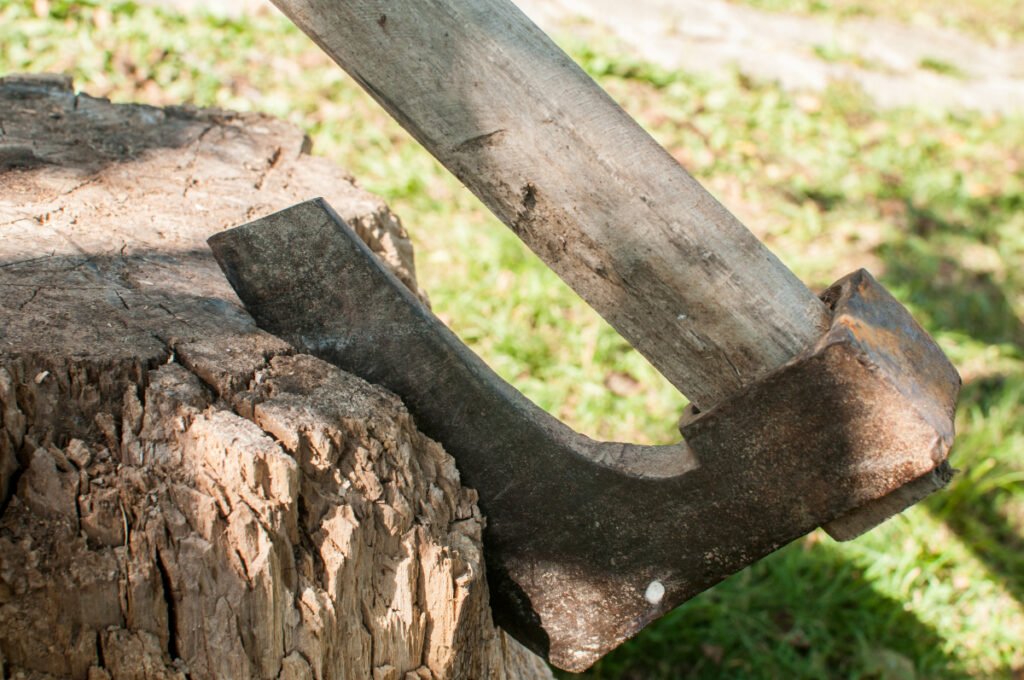Are you planning to resell your grandfather’s old carpentry tools? Well, search his shed and see if you get any funnel-like broad axes. And if that axe looks old and rusty, it’s a jackpot! That’s because you don’t get broad axes now! So, they are rare and in demand!
But at what price will you sell your broad axe? To calculate it, you must see if it has any special features. And today, I’ll help you spot those features in this antique broad axe price guide! So just clear the rust, and check the details with me!
Key Takeaways
- Old, handmade broad axes don’t have any marks or numbers. So, look for twisted heads, hammered blades, and bevels to trace their age!
- You can get two types of antique broad axes – single and double bevel. Of these, the double-bevel one is costly, while the single one is usable.
- Pick antique broadaxes with an ash, maple, or cherry wood handle for the best returns.
- Check if your axe’s blade is stone, iron, or brass. Otherwise, it might be new and cheaper.
Identification Features of Antique Broad Axes

Hold your broad axe with its sharp edge away from your body. Now, see if it has one flat face and one bevel face. If yes, it’s an antique broad axe costing $200 – 500. If not, it might be a new, forged model. So, check the bevels properly!
But what if your piece is rusty? Checking the bevels becomes tough, right? So here are more features to check:
- Twisted sockets with 5 – 6 inch clearance and flat edges
- 20-inch long axe with a 7-inch blade and over 8 pounds of solid wood handles
- Scissor-shaped bevels with a 330mm sharp edge and hickory throats
- Concave axe shoulders and flattened toes, heels, and knobs
History & Evolution of Broad Axes
Can you guess what the first broad axe was made of? Well, it was stone and bone, just like any other Stone Age tools! But what is different is their precious, handmade designs and lacquers! Plus, you might love their hammered blades and handles, too!
Metals came into the picture in the 1800s, so the makers used all of them—bronze, iron, and copper—for the blades! But these pure metals rusted with age and lost their sharpness. Most of them are rare and precious today!
The later 1900s era was tricky! Like, makers did use steel alloys for light, fancy broad axes. But, people stopped using it and moved to the flexible felling saw! So, you’ll get these axes for less money!
2 Types of Antique Broadaxes With Values
It’s true that broad axes don’t have many designs! But we can divide them into two types based on their use and blades to guess the price!
1. Single Bevel Broad Axe

As the name suggests, single-bevel axes have one flat and one chiseled edge. So, they have a wider one-side swing and a curved handle for better grip. They also have rough, bog-iron edges and fired blades for easy cutting. These axes are sturdy and cost $200 – 300.
2. Double Bevel Broad Axe

Check if your broad axe has two chiseled sides and scallops. If yes, it’s a double-bevel axe! You’ll also see straight handles, flutes, and a double-swing blade with these. Plus, most have a stamped, cast-steel blade and seasoned handles and cost $400 – 500.
6 Factors to Identify & Value Antique Broad Axes
Bevels change every antique broad axe’s value, just as we saw. But do you know that even age and materials impact its total cost? Let’s see how!
1. Axe’s Manufacturing Date & Age

We all love ancient, Neolithic-era tools for their handmade make, right? So, if you want crude, rusty artifacts, pick the 1700s models. And, if you want it durable and metallic, the 1800s models are the best!
But, if you want a usable Broadway, pick the 1900s model. Here, you can pick axes with a double swing and head for better cutting.
But most antique broadaxes don’t have any date! So, I’ll tell you how to guess its year!
How Do You Spot a 1700s Broad Axe?
If your broadaxe has crude bone or wood handles, a one-side swing with short handles, it must be a 1700s broadaxe! You’ll also see bog iron blades and oxidized edges, valued up to $600. Plus, there won’t be any welding marks or numbers!
How Does an 1800s Broad Axe Look?
Look for broad axes with welded ferrules and flat slopes on either side. This one even has hand-hammered blades and machine-polished handles! Next, check its weight! If it’s 6-7 pounds, it’s an 1800s model, costing $400. But if it’s lighter, it might be new!
How Do You Spot Old Broad Axes from the 1900s?
Check if your broad axe has 4-5mm steel blades with sharp, tempered edges. Also, measure its handle. If it’s long, about 16 – 17 inches, it’s a 1900s axe! You can even see some etched patent numbers or logos with them! So most of these are branded, costing $100 – 300.
Here are some antique broad axe patent numbers for help!
| Year | Age | Patent Number | Average Valuation |
| 1900s | 123 years | US8925207B2 | $300 – 450 |
| 1986 | 37 years | WO1988000112A1 | $200 – 300 |
| 1984 | 39 years | US4586258A | $100 – 150 |
Check if the broad axe comes in both the right and left swing versions for the best returns.
2. Handle’s Wood Type

Well, it’s obvious that every broad axe has a wooden handle! But, if it’s straight-grained or seasoned wood, you can raise the costs by 5 – 10%. Similarly, you’ll have a fast resell if the handle has natural wood knots and blemishes.
But, if your handle has a new stained wood or MDF handle, it might not cost that much. And even composite or faux wood handles are a big no for high returns!
Want to know how wood impacts broad axe value? Here’s a price guide:
| Old Broadaxe Handle’s Wood | Average Valuation |
| Ash, Maple, European Beech | $160 – 200 |
| Hickory, Alder or Willow | $100 – 120 |
| Birch or Cherry | $80 – 100 |
| Red Elm or Pine | $50 – 80 |
| Pecan, White Oak or Red Oak | $30 – 40 |
| European Birch or Basswood | $10 – 20 |
Pick axes with lacquer, oil, paraffin, or shellac-finish handle for high returns.
3. Blade Materials

Get a scale and measure the thickness of your blade. If it’s 15 – 20mm thick, it might be of stone or microlith. But if it’s 10 -12mm thick, you might have a metallic cast iron blade. And you can price such axes for $100 – 120.
But, if the blade is very thin, say 4-5mm thick, it might be steel or aluminum. So, you won’t get more than $60 for its new machine make!
Here’s a list of how different blade materials impact a broadaxe’s cost:
| Old Broadaxe Blade’s Materials | Average Valuation |
| Stone or Microlith | $100 – 150 |
| Cast Iron & Zinc | $100 – 120 |
| Brass, Bronze & Copper | $80 – 90 |
| Alloyed Steel & High Carbide Steel | $50 – 80 |
| Stainless Steel & Aluminum | $40 – 60 |
Avoid buying shiny or galvanized blade saws as they might devalue your axe by 10 – 12%.
4. Antique Broad Axe Makers

If you want a polished, high-quality broad axe, get the ones signed by ‘Kangaroo’ or ‘D. Drake.’ These branded axes are not only fancy but also hike your broad axe value by 20 – 25%. What’s more? They even come with superior cutting edges and heels for easy chopping!
So, to check your broad axe’s brand, look for logos or marks on its handles. Or see if they have a ‘Made in London’ stamp for a foreign make. If yes, you can price your piece up to $500.
Check out these vintage axe brands and their estimated costs for help!
| Old Broadaxe Name | Manufacturer | Average Valuation |
| Rafting Axe with Gum Handle | Collins | $130 – 150 |
| Coopers Broad Axe | Kolp & Seybold | $200 – 250 |
| Shipwrights Broad Axe | Kangaroo Works, Sheffield | $100 – 120 |
| Stained 31” Broad Axe | JM Sheffield & Co | $150 – 200 |
Get broadaxes with floral or bird carvings for a precious foreign make.
5. Broadaxe Colors

You’ll get old broad axes in two colors – bare wood and oxidized. Of these, the bare or stained wood ones are more precious, costing $300 – 400. In contrast, oxidized white, black, or brown axes are cheaper, up to $200.
Avoid getting painted or powder-coated axes, as those might be new and cheaper.
6. Weight
Weigh your broadaxe on a pair of scales. If it weighs 7 – 8 pounds, it’s an antique model, costing $400 – 500. If it weighs slightly less, at 4 – 6 pounds, you might have a new $200 model. But, if it weighs less than that, it might be forged or fake.
How Long Should an Antique Broad Axe Handle Be?
Antique broadaxes usually have handles of 16 – 17 inches. But if they’re longer than that, they might be new and machine-made.
Do You Oil an Antique Broad Axe?
Yes, you can oil your broadaxe’s blade with any vegetable or Rem oil to clear the rust and fungus. Or, you can grease it with paraffin or WD-40 lubes for the best results.
How Often Should You Grease an Antique Broad Axe?
If your antique broad axe is in good condition, grease it once a year to save it from damage. But, if it’s already rusty, oil it twice in 6 – 7 months.
How Do You Clean an Antique Broad Axe?
Cleaning antique broad axes is really easy! Start by scraping the dust with a scouring knife and thoroughly rinsing it with soap and water. Next, dab it with paper towels and dry it for 4 – 5 hours. Your broad axe is now ready for storage!
Pricing antique broad axes is no longer a tedious job! Now that you have our guide, you can check the age, handle, and value of your axe yourself! Just be sure to wipe the piece properly. You don’t want to miss any details and marks, right?
Also, get a wood block and try to flatten it with the axe to test its sharpness. But hey! If a broad axe is heavy, you can get a wood plane for your chisel work. And here’s a quick guide to know everything about ‘antique wood planes.’
Note: This article is intended for informational, educational, and entertainment purposes only. Some images are illustrative and may not represent actual brands, products, or related entities. All trademarks, product names, brand logos, packaging, and other intellectual property referenced remain the exclusive property of their respective owners. Any brand mentions or references are provided solely for descriptive and educational context and do not imply any formal or commercial association.










